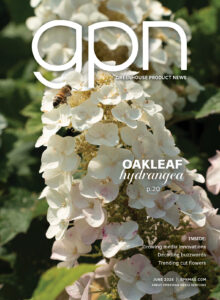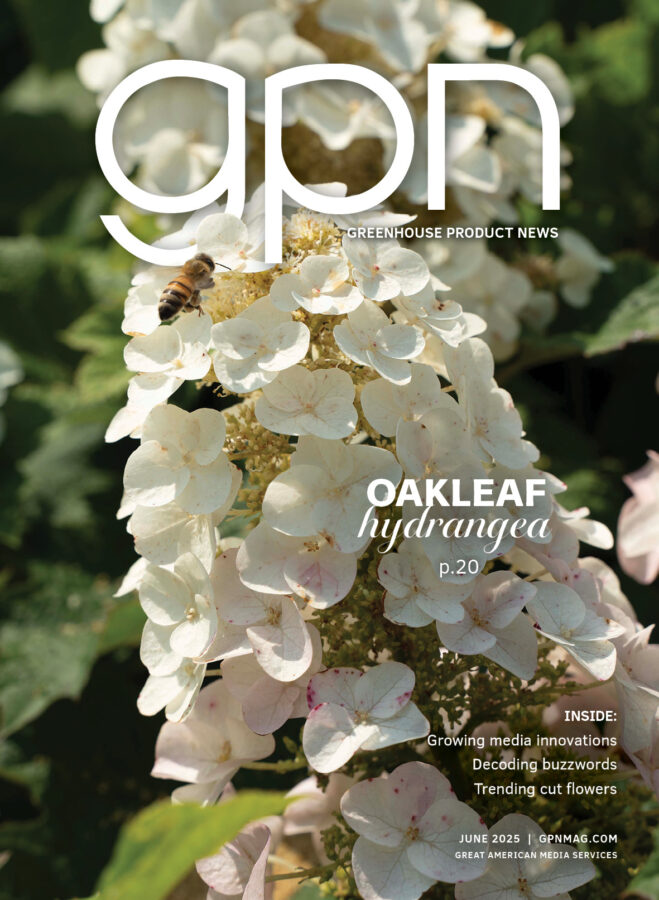The Role of Sprayers in Providing Spray Coverage and Greenhouse Pest Control
Greenhouse and floriculture crops represent an important part of agribusiness, with more than $5 billion annually in farmgate receipts. Clearly, this is an important business that must consider how to maximize efficiency in all areas of production, including pesticide application. A variety of methods are used to treat floriculture crops with pesticides, including hand-held and stationary whole-room sprayers. While few recommendations are available to help growers understand how to best use their equipment and contain costs, this preliminary study attempts to discover the best use of these sprayers based on where the spray is being deposited.
The Equipment
Equipment used in the preliminary tests included an air-assist electrostatic handgun sprayer, a high-pressure handgun sprayer and an air-assist whole-room fogger. The electrostatic sprayer (ESS, Watkinsville, Ga.) uses a compressor to supply air that atomizes spray leaving the nozzle, as well as to help deliver spray material into the canopy. The ESS sprayer creates a negative charge on the droplets as they pass through a high-voltage ring that is located near the outlet of the handgun. It produces very small droplets, which benefit the most from charging.
The other handgun sprayer was a Dramm Coldfogger handgun sprayer (Manitowoc, Wis.). The Dramm sprayer also produces relatively small droplets because spray liquid moves through the nozzle at very high pressure. A Dramm Autofogger (Manitowoc, Wis.), a whole-room fogger, was used to treat the entire greenhouse from a stationary position at one end of the structure. The Autofogger produces smaller droplets than the other two sprayers. Because they are so light, these smaller droplets can be transported around the house by in-room, air circulation fans and the circulating fan on the fogger. The ESS sprayer, Coldfogger and Autofogger each used 2.4, 5.3 and 1.9 gallons of spray solution, respectively, to treat the 20,000-sq. ft. room.
The Subjects
All of the equipment was used to treat either poinsettia or fuchsia plants in 8-inch plastic pots. Plants were placed or hung in areas surrounded by other plants in 12 different locations around the greenhouse. Each sprayer was used to treat the entire greenhouse on a different day.
The tank mix included a fluorescent dye that can only be seen using an ultraviolet light. Following each treatment, a few leaves were taken from the top and middle of the sample plants. These leaves were examined under a microscope to measure the number of droplets on each leaf and the total area of spray material coverage on each leaf. Both the bottom and top surfaces of the leaves were evaluated.
The Results
All sprayers produced much higher spray coverage on the tops of leaves compared to the bottoms. All sprayers also produced better coverage on the leaves taken from the tops of the canopy compared to the middle. Coverage was higher on plants taken from the rolling benches than from hanging pots.
The Autofogger produced the fewest deposits on each leaf, and thus had the lowest spray coverage. The whole-room fogger, however, produced remarkably similar coverage results throughout the entire greenhouse space. Plants directly in front of the fogger received a little more spray coverage than others did; however, there was usually very little material found on the bottoms of leaves that it treated. More spray coverage was found on leaves treated by the electrostatic sprayer than the other machines, especially on the bottoms of leaves. The Dramm Coldfogger sprayer produced slightly larger droplets than the ESS sprayer. The Coldfogger also generally deposited more material on the undersides of leaves of bench plants than the Autofogger, but coverage was consistently lower than that produced by the ESS sprayer. The Autofogger produced higher coverage on hanging baskets than the Coldfogger both in the top and middle of the canopy.
There were differences in the coverage produced by the Coldfogger treatment depending on the width of the benches treated in a single pass. Walking down the alley between two 5.5-ft. benches and sweeping the spray pattern back and forth across these two benches produced better coverage than trying to treat between two 11-ft. benches. The same spray volume was used in each case, but the total spraying time was a little more when treating across just two 5.5-ft. benches because the operator needed to walk down more alleyways. The ESS was also used in a way that treated two 5.5-ft. benches as the operator walked down the alley between them.
What it Means For You
These and future studies are designed to learn how to apply greenhouse pesticides most effectively. While these initial studies have not included an examination of the biological effectiveness of each machine, they do provide lessons on where they deposit spray material and how to improve coverage, if needed. More directed sprays are able to penetrate a canopy better and can put more material on the bottoms of leaves than a stationary fogger. This may require more time, but could well improve pest management efforts. High-pressure sprays do not necessarily ensure good canopy penetration and coverage on the bottoms of leaves. Air-assist, electrostatic spraying may provide the best opportunity for coverage on the bottoms of leaves, if needed.
A portion of these research findings was presented at the BCPC Conference on Pests and Diseases in Brighton, England, in November 2000 and is available as part of the conference proceedings. While these findings are important to help understand spray coverage and its distribution, it is more important to understand the mode of action of each pesticide used and where it must be applied to be most effective. Future studies will evaluate the amount of pest control each type of sprayer provides, as well as the fate of spray material within plant canopies.
Product and company names are necessary to report factually on available data; however, the USDA neither guarantees nor warrants the standard of the product, and the use of the name by the USDA implies no approval of the product to the exclusion of others that may also be suitable.









 Video Library
Video Library 


















